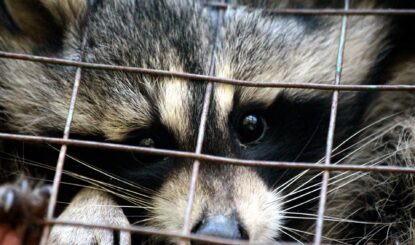The Most Cruel Fad
Fur is everywhere again. The animal-despising fashion literally pulls the fur over our ears with pompoms, borders and fluffy hoods. The result: unimaginable suffering for over 100 million fur animals. But fur is only beautiful on the animals born with it!
January 2017. Tram station Estazione de Trastevere, Rome, Italy. Rain. Cold. I get on a half-full tram. It stinks of dog – of wet dog. But nowhere does my searching gaze encounter a faithful four-legged friend. What my eyes discover instead makes me shudder: About three-quarters of the passengers are wearing fur! Fur trim on hoods, gloves and boots. Pompoms on caps and handbags – all real fur! Now it’s clear why it stinks of wet dog. The decorative fur, which is not even warming, comes mainly from racoon dogs which belong to the canine family. At the next stop, an elderly lady gets on the tram with two dogs: one on a leash and the other dead, skinned around her neck. What is this ignorance all about? How can you love one and at the same time carry the other one around your neck as a corpse? How can one disconnect oneself from common sense in such a way as to not make this connection?
A billion-dollar industry
We have seen better times. In 1994, when the five most famous top models posed for the campaign “I’d Rather Go Naked Than Wear Fur”, it looked as if the market had said goodbye to fur. Wearing fur was frowned upon, even a social crime. However, two decades later, in 2015, 73 per cent of the 436 fashion shows in New York, Paris, Milan and London featured fur. Fur farms now flood the trade and production has more than doubled from the 1990s to 2016, to one hundred million furs annually.
The fur industry is a very lucrative business. A 2014 study commissioned by the International Fur Federation states that the fur industry’s yearly turnover is more than 40 billion US dollars worldwide.
A bloody and stupid trend
The big designer brands have broken the taboo; brought fur back onto the catwalks and thus reintroduced the trend of wearing fur. The fur industry is trying by all means to change the public perception of fur: from unnecessary, decadent, cruel to beautiful, modern, natural. The fur lobby has developed clear strategies to bring fur back into the market as normality. For example, young designers are showered with fur samples to incorporate into their creations. Big brands set the trend and the smaller ones follow. It is not uncommon to find even non-brand jackets with real fur trims for as little as 50 euros. After all, a Chinese trader only gets the equivalent of about 4 euros for a piece of fur that is suitable as a hood trim.
The Kim Kardashian-It-girls wear it and via social media, it is portrayed as beautiful and trendy. The young are desensitised so that even the nice girl next door wants it too. But when we understand how much animal suffering is behind this; how much blood is on every single piece of fur for which the consumer is ultimately responsible, things start to look very different…
Immense animal suffering
No matter if from a farmed or wild-caught animal, every piece of fur has meant unimaginable suffering – and death – for its original owner. The killing methods are absolutely cruel. In Europe, the gassing box is mainly used. In China – which produces 80 per cent of all fur worldwide – cat, dog, mink and fox are beaten to death, strangled, hanged, drowned, poisoned, killed by anal electrocution, or simply directly skinned alive.
Additionally, the conditions in which the animals are kept on fur farms are abominable: the sensitive creatures suffer agony in cramped, filthy wire cages. But it is not only in China that animals are kept horrendously and killed brutally. Research on dozens of fur farms in Finland, Sweden, Norway, Denmark, the Netherlands, Poland, Germany, Russia and the USA shows that animals are also waiting for their execution under the most brutal conditions. Fortunately, Switzerland does not tolerate fur farms. But: by importing and buying fur products, we in this country are just as much responsible for the repulsiveness of the booming fur industry.
What about artificial fur?
This is where opinions often differ: On the one hand, people say that synthetic fur products also promote fur sales overall, since faux fur is hard to distinguish from real fur due to the lack of clear declaration, and thus promotes wearing fur in general. On the other hand, synthetic fur makes the chic fur coat possible without any animal suffering.
Moreover, real fur products pollute the environment: toxic chemicals are needed to preserve the animal skins from decay. Denmark alone releases several tonnes of ammonia every year to preserve the skins of over two million killed mink. Hence, real fur can in no way be considered a “natural, renewable, biodegradable resource”. And certainly not as modern and beautiful – because fur is and remains only beautiful on the animals born with it.
| Real or faux fur?
There are two simple tricks to distinguish between real and artificial, faux fur: 1.) Cut a few hairs off the fur and burn it. If it smells like burnt hair, it is real. |
|
Refrain from wearing fur – neither bought nor received as a gift! If not clearly declared, always ask in the shop whether it is real or artificial fur. In the case of real fur, approach the shop management and make them aware of the cruelty behind this product. Demand a clear declaration. Talk to fur wearers on the street and make them aware of the cruelty involved in fur production. Only education and action can combat ignorance and raise people’s awareness and compassion! |
More information:
- Our project page: Fur


